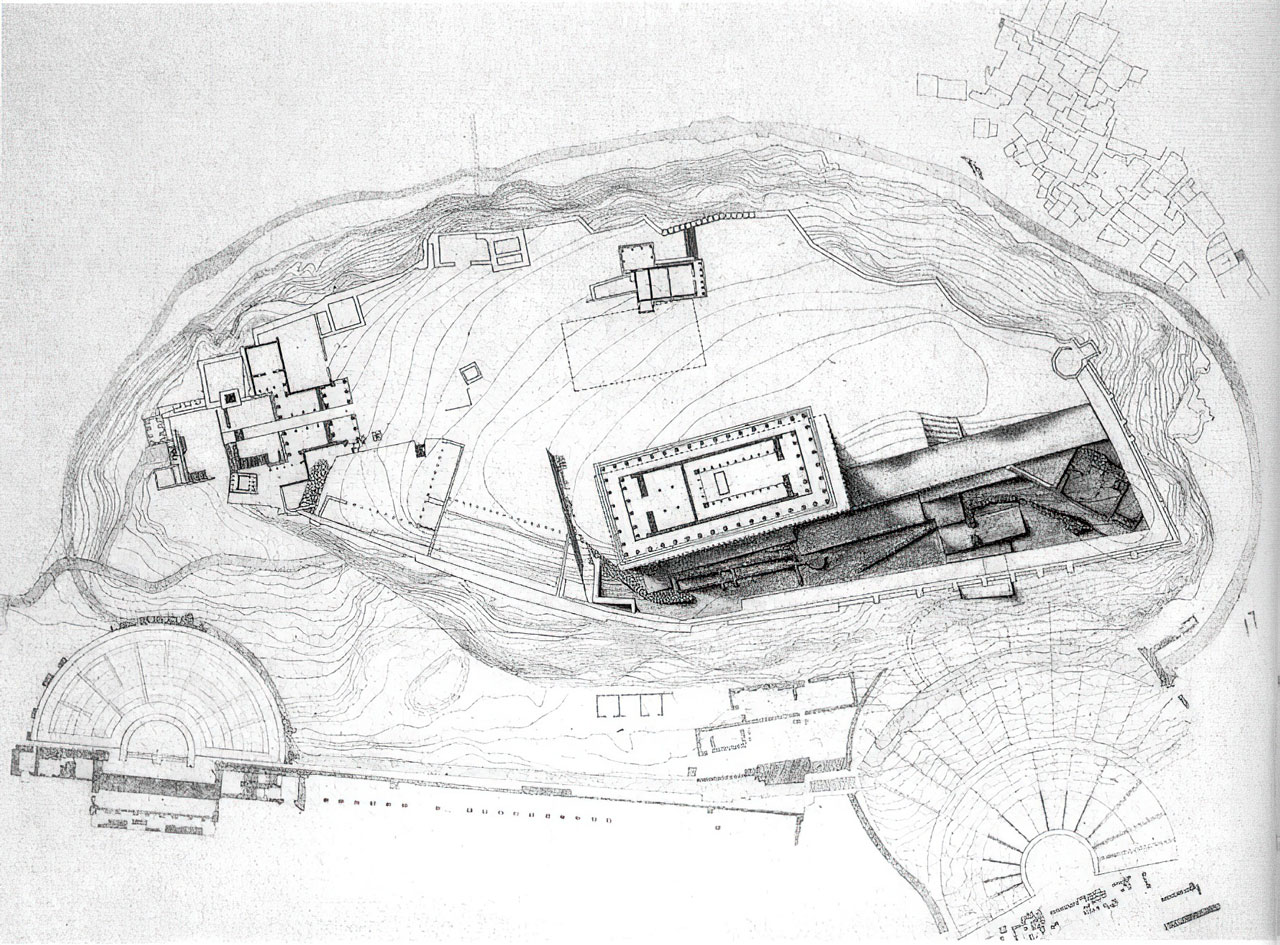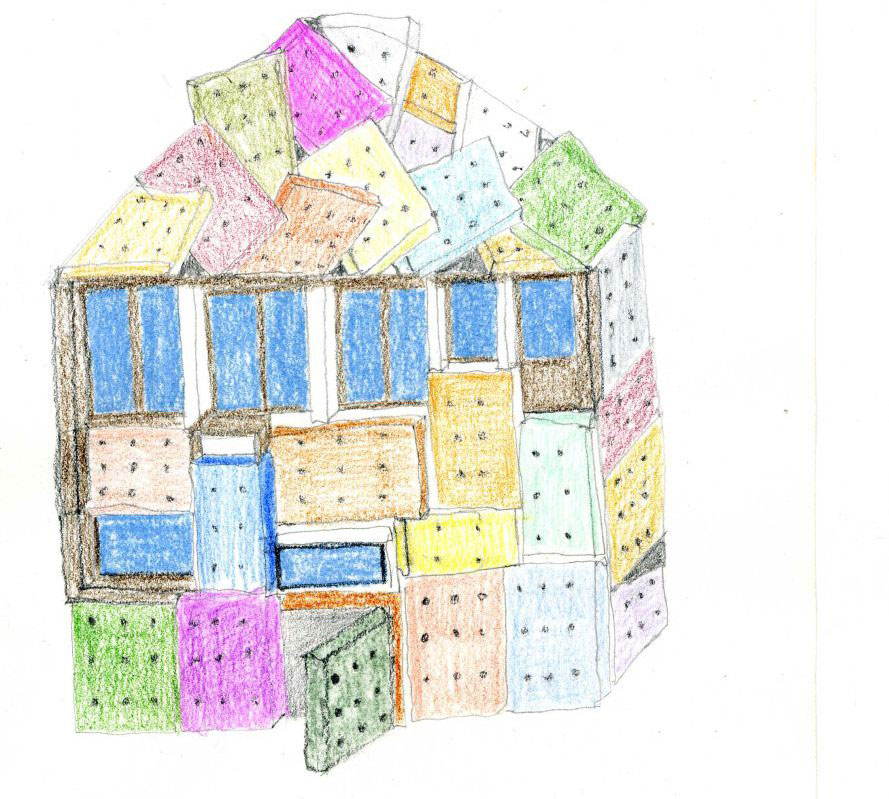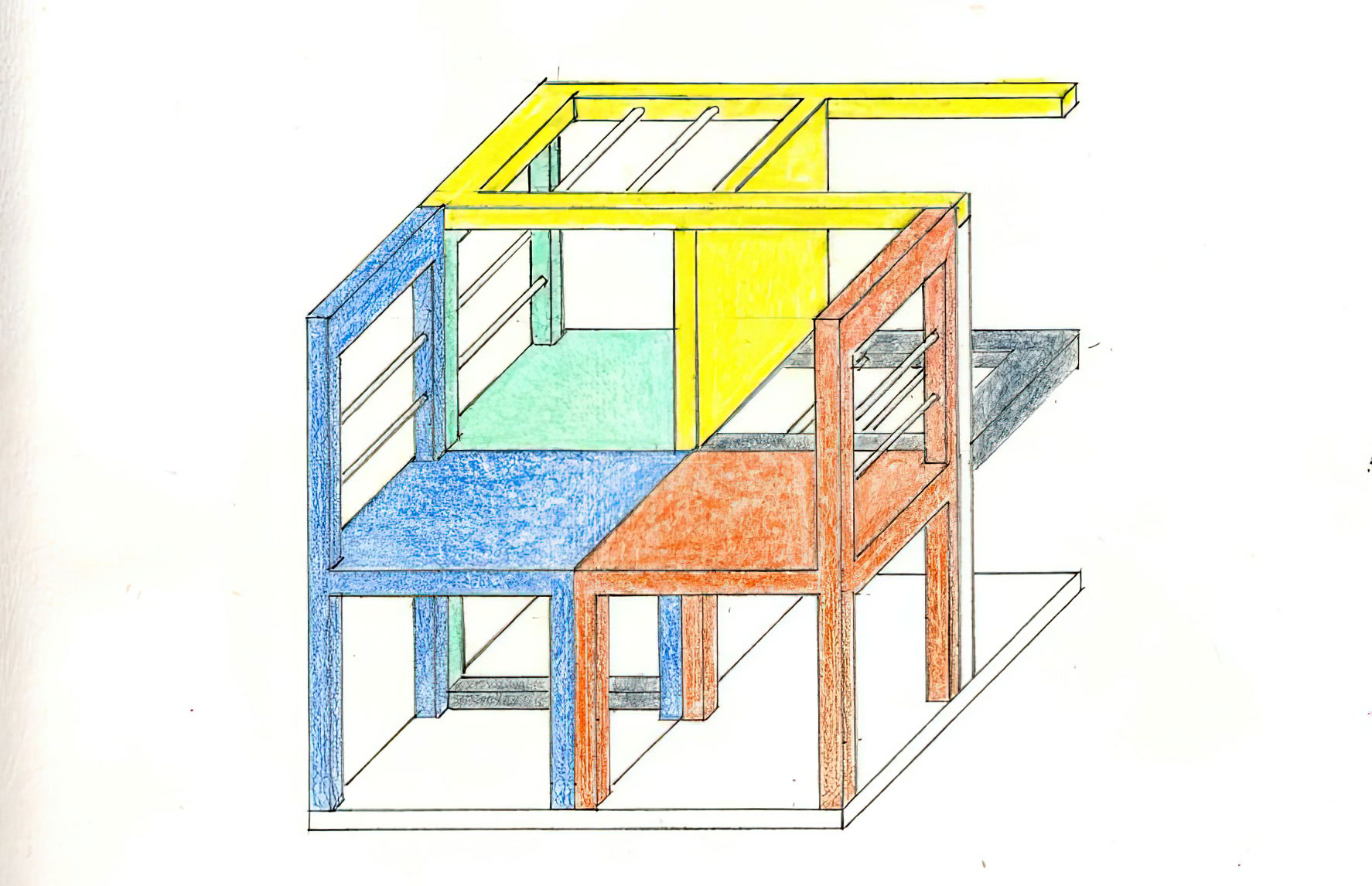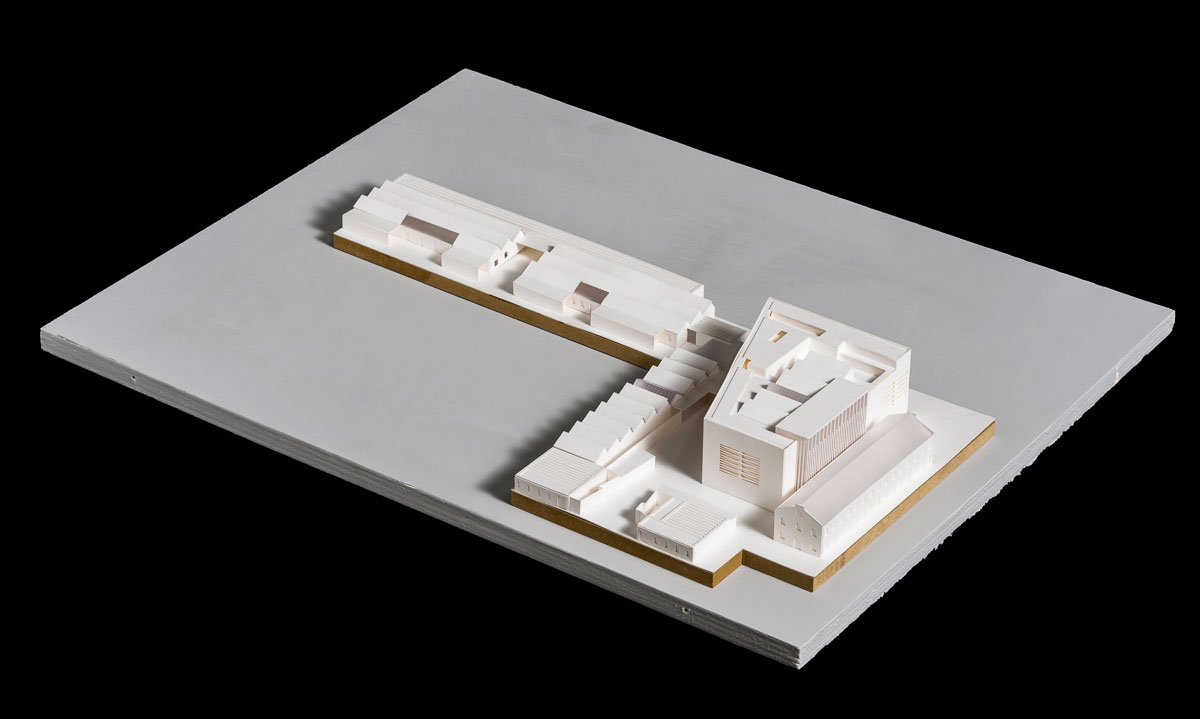ARCHITECTURE: Christos Papoulias (19/9/1953- 8/6/2024)
 My relationship with Christos Papoulias begins in 1993, initially with a refusal, on the occasion of the supplement “Seven Days” of Kathimerini newspaper about Hydra Islan. The people who introduced him to me told me that he knows the all the important people who come to Hydra and that he builds the best houses. The truth is that it does not build but rebuilds, because Hydra is the last model settlement that Melina Mercouri ratified before before her death. So, after skipping sayings and objections, Christos Papoulias became my mentor, in the field of art and architecture… In a relationship that evolves over time and counts twenty-eight years. The following interview took place on the occasion of his participation in the Venice Biennale of Architecture in 1999, at the personal invitation of its Director Harald Szeemann, it has been followed and preceded by discussions and reflections, since 1993 in Hydra, later in Athens at his home in Anafiotika, the Documenta of Kasel who presented his works in 1997 and not only… In essence, it involves an open dialogue between us in time…
My relationship with Christos Papoulias begins in 1993, initially with a refusal, on the occasion of the supplement “Seven Days” of Kathimerini newspaper about Hydra Islan. The people who introduced him to me told me that he knows the all the important people who come to Hydra and that he builds the best houses. The truth is that it does not build but rebuilds, because Hydra is the last model settlement that Melina Mercouri ratified before before her death. So, after skipping sayings and objections, Christos Papoulias became my mentor, in the field of art and architecture… In a relationship that evolves over time and counts twenty-eight years. The following interview took place on the occasion of his participation in the Venice Biennale of Architecture in 1999, at the personal invitation of its Director Harald Szeemann, it has been followed and preceded by discussions and reflections, since 1993 in Hydra, later in Athens at his home in Anafiotika, the Documenta of Kasel who presented his works in 1997 and not only… In essence, it involves an open dialogue between us in time…
By Efi Michalarou
Let’s start with the Acropolis Museum, both the Acropolis proposal and the Urban Rooms are two projects that we saw in 1997 at Documenta in Kasel.
Although both proposals have common starting points and common concerns, they are not just two museums, but two proposals that try to take the idea of the museum a little further.
Let’s start analysing them one by one. The Acropolis Museum is a project that you have been working on since 1977 and presented at this year’s Venice Biennale, at the personal invitation of its Director Haraald Szeeman.
This project today is a moral response to the state’s plans to build a new Acropolis Museum. In a city that has very little to do with the monument, Athens surrounds it, but in a chaotic situation, where the dialogue between the Acropolis and its surroundings is non-existent as well as between modern architecture and the Acropolis, this was a counter-proposal, which is why it had never been given to the jury, although it took place in parallel with the third international competition.
What is your Proposal and how does it differ from the rest?
To remain the absolutely necessary, that which is part of the Acropolis, which is a sculpture and architectural construction from Pentelic marble above, as are the rest, and not to refer to modern buildings. Why? Not because the rock is sacred. My suggestion, first of all, was made for the Archaics and by extension for all the rest. They should remain on top of them, because they were not sculptures, but xoanon of deities, and Pericles, when he made this rubble, which that is what I propose, the opening of this large rubble surface in the aisle of the rock, was done in order to increase the surface of the rock and allow the Parthenon to have around its space towards the Areopagitou street and the Theater of Dionysus. This is how the new walls were built and the base of the Parthenon is inside this pit. The Archaics were put by Pericles (his time0 there because they were revered as deities, they were not thrown away – nor destroyed, nor taken to decorate their villas by the Ancient Athenians. Even the way we found them, it was like a burial, like babies, we have the archaeologist’s drawings, which are placed next to each other, I imagine they had wrapped them in sheets. Potentially, the museum existed on the Acropolis, I was looking for it…
Your proposal is born of the need….
To preserve the sculptures as fragments of a whole, which is the Acropolis itself and consists of different buildings, of different eras, but this whole unity is one thing. The relationship they may have with a modern metropolis is non-existent, a dialogue with the Eye made by the Italians architects cannot be restored, this banal idea is a purely visual idea, formalistic, I am referring to a psychological rehabilitation and kinship that the sculptures will have. You can’t have such affinity with a titanium building like the Bilbao Museum, that’s where you aesthetize the exhibit.
Your proposal is completely different.
Exactly! The sculptures should not leave their mother, they should remain on the rock, in order to have the aura of the rock. Otherwise, the Museum of Frank Gehry or any other famous, great architect that Greece would invite to do it, with or without a competition, would not have the aura of the Acropolis, but of Gehry. My example is specific to understand. Put Phidias inside the Bilbao.
You can’t. Converts to design.
Exactly!!! They won’t shy away from design. My suggestion is a chthonic place-buried, which existed, it is a potential museum, where the archaic ones were found, the rubble of a human hand, those who built the Parthenon. This space, I propose to reopen, there are even the marble scaffolding, where the Parthenon was built. It is a workplace, not a plot to build a masterpiece of modern architecture. It’s a museum that comes out…
From the bowels.
Exactly. I want it to become a Museum for the Acropolis that does not have the signature of an architect. I disappear behind the place. I am a kind of strategist. It is not a museum that will say look at the Papoulias Museum, as they say today: Look at Gehry’s Bilbao, there you will not even associate the name with the Museum, because you will not see it. You will descend to this place that will subject you to awe, there will not even be lights, there is natural lighting, let’s not forget that the Acropolis closes at sunset. Everything you see – you see in a place of awe. It is a crypt. The act that Pericles did to bury them in this rubble, the same act metaphorically and with other analogies more modern, I propose. Let us ask the question, if Pericles had high technology in the 5th century BC, he would not have buried this space, but would have built a roof, as I suggest, and made it like a crypt. Because he could use it to make cisterns, spaces for ammunition or warehouses for feasts. And as modern as he was, he would consider using that crypt too and throwing a plaque at those sizes.
When you gave the lecture in 1991 at the Ileana Tounta Gallery, the archaeologists reacted strongly. For what reasons?
They froze because they are conservatives. Their problem is to live an almost undead life. With the awe of the sacred rock in an academic and pseudo-serious way. The monument lived all the centuries and breathed with works. The Franks made towers, the Turks built a mosque inside the Parthenon, they did not destroy it. We dismantled everything and left a purity of Antiquity…They froze, because the thought that I am doing a surgery on the Acropolis, let them take a closer look at my proposal. I didn’t drill rocks, I didn’t vandalize. Pericles closed up a space that I suggested it should be undone, because there is a huge space. The proof is that the small existing Museum inside the Acropolis was built inside this hole. What I propose is to lower another three floors below the existing one and extend it to the whole extent of the rubble. It is an instructive Museum, in situ, because you see the construction of the Parthenon, which has a base 13-14 meters below…and finds the rock which is solid of Piraeus stone. You see the ancient walls, before the classical period, the Mycenaean period, you go to the root of the rock and time.
Is this how the cross sketch is decoded?
They are the horizon and the time; they give a new museological dimension. I go back in time…on foot, with my own body… it is a descent into the Parthenon, into a crypt. We would give the Acropolis a tremendous awe.
In this way, you review the past and the viewer acquires a direct relationship with the space and history.
Let’s make an assumption, that if my proposal had been built, Athens would have got rid of a huge chest, which does not fit in these areas. We are talking about sensitive areas with small neoclassical houses around the Acropolis, the historic centre. You would have the feeling that behind the rock, behind the wall, passing by Aeropageitou street, which as they say will be pedestrianized, there is the Museum where everything is kept there. It would be a museum that you didn’t see, but felt inside the city.
Why was the third contest cancelled? What happened to the Italian architects Passareli-Nicolleti?
It is complex, for formal reasons. It had already been annulled at the time by the Council of State, but that didn’t matter, because Melina Mercouri said at the time: Yes, but I found architects from this competition and I awarded them the project directly. Something that has been done many times in the world. What matters to me is not whether it was cancelled, but that it was wrong from the beginign. What the Greek state did not know, because the people who are advisers in the ministries, are a bit retarded.
How was it conducted?
In a way that only Ceausescu’s Romania does, Indonesia and other third world countries. With UNESCO. You don’t have competitions with UNESCO, you have an old academic from the Soviet Academy in Moscow and a Bulgarian and some unrelated people as judges. How will star architects make suggestions when they don’t know who the Judge is?
The goal behind all this is the return of the Parthenon Marbles?
Yes, it was blackmail. A third world attitude of our country, to want to build a museum, an empty room in order to blackmail: Do you see what a beautiful Museum we have? But this Museum, which they were going to build, nobody said it was nice. It would backfire on them… Look, if the country doesn’t have a developed culture, it’s ridiculous to ask for marbles. Since we don’t have a museum, we shouldn’t have asked for them at this point in time.
What should she do?
To build, silently… and five or six other museums at the same time, to have both one Contemporary Art and one Modern and one Kunsthalle, and since it has a superior culture and an Acropolis Museum state-of-the-art, which it has done with the right means, after culture has risen, then it starts pushing and asking. With one person you ask then and with another now, as a stupid relative who asks for his stolen goods and has no place to put them. He invites third-class architects from Rome, who build shopping malls, to build the Acropolis Museum and insists on having them all these years. Here the grotesque Greek bureaucracy is proven, was no one able to tell them that it was an abortion of the ’60s – an outdated architecture? No country would build it, and how much money did they spend with the Italians?
Who knows?
It would be over by now if they had done the contest correctly. Were any of those who made the mistake fired? The people who control museums have still been directors and consultants to museum services for twenty years, even though they have made many mistakes. All the museums that take place today, the archaeological ones on the islands and elsewhere, are like chicken coops. They are given by the law 7/16, no competitions are held. In the country of museums, of the 120 archaeological, perhaps more, built in the last twenty years, we do not have to promote a single one as an architectural building!
Can’t the Association of Architects do something?
Absolutely nothing, because there is the dictatorship of the employees. If there is a mistake at the moment and we do not have the Acropolis Museum, no minister is responsible, the museum service of the Ministry of Culture, which still operates Stalinist, closed, third world and fascist…
As far as we know, the greatest architectural theorist, Kenneth Frampton, sent a letter with the 25 signatures of world-famous architects, to the Minister of Culture, Mr. Evangelos Venizelos, preventing the construction of this museum, what happened?
Kenneth Frampton, in a letter-manifesto, wrote not to build the Pasarelli-Nilleti Museum, because it would be a disgrace to the Acropolis and Greece. Theu continue…however… They don’t say we made a mistake, is lost the word sorry in this country? That’s why we won’t have a museum and neither will give us the Elgin Marbles. There were wars to convince Melina Mercouri that the Makrigianni plot was wrong and Koili and Dionysus were the alibi, they deliberately attacked them, they knew they would not give prizes there.
You have presented this project through lectures, but also in major international institutions abroad, what was the response?
It seems from my book* that everyone has accepted it, even Raimund Abraham, when he got the third prize, was in a lecture of mine in 1991 at the Academy of Vienna and said: “I may have won the third prize, but Papoulias’ proposal, compared to mine, is better”.
Since we are talking about Museums, should we examine what kind of Museum can and should look like in the future?
The answer comes from Ljubljana…
The project ”Urban Rooms”, as we know, started as a workshop…
I wanted to get the students, because they were architecture students and didn’t have much to do with art, through Pistolleto’s “Objecti Imeno”, to see them as urban equipment and work with them. But the idea through the seminars was that I was looking for an answer to my own questions. The question
what the Museum is”, is not only mine, it has been raised throughout the century. For me it was never enough to sit down and design a museum, because I do not accept orders to execute them, from the customer. If the client is the state and tells me make a proposal for the plot in Makrigiannis, I go and put it on the Acropolis, as you have seen. So, in Ljubljana I went to do something similar.
You have started research through your work…
Twenty-five years ago, to find a way to exhibit public art in the city, which as we know suffers.
It is non-existent.
Not only in Greece, in no country. Especially, now with the 1% law created in Europe, it will come here too, every Public Building when it is built, an artist must get 1% to make an artwork, inside or outside the building. And abortions have been created, that’s why you see glass buildings and a small piece of shit at the entrance, it’s a sad state of how contemporary art stands in the city. He cannot communicate with either the residents or the city. It is not in dialogue with urban planning, nor is the most conservative art, like “Drome” Vrotsos. So, I said, let’s get to the root of the problem…
Which is it?
In the Academic City of 1800, there was a pedestal, where the axes of urban planning joined, the large boulevards and the avenues ended in a pedestal and there was a statue. The pedestal was a symbolic “House of Art”, closed-silent, that highlighted art, therefore, the pedestal was related to urban planning and the axes of the city. From the moment we lost it, because modernism rejected it – it shaved it, no one puts his works on pedestals anymore, nor does he think of doing axial urban planning, where all the streets end up in a square, because this is the urban planning of power. I was looking for a substitute for the podium.
Essentially, the podium also gathers energy, which is otherwise dissipated…
Yes, and it gives the aura to art. The artwork had a house that was lost and we need to replace it, to find within modern thinking, modern strategies, a way for contemporary art to exist in the city. Why should live artists of the same age as me enter museums and buy a ticket to see them? A collection of past artists I understand this.
It is common to complain that people do not understand contemporary art…
But no one educated him, in Ljubljana, I told the students: “The city needs contemporary art, but it needs to solve other issues, one of the things I see, as an architect-urban planner and diagnostic, is that its river is too narrow and does not live. Look for us to take the city down one floor, make a bank near the water and put art there, take the “Objecti Imeno”, which is easy to work with and can be placed in.” So, to make an underground passage that is both a museum and not a museum, for people to enter with shopping bags from the market and for the doors to open automatically. No tickets, no t-shirts, no card-postal, no nonsense, no toilets. It has toilets, but hidden, in crypts and a guard who looks with monitors, so that the other does not enter with spray paint and destroy the artworks.
Why do you think that things are not progressing with Museums in their current form?
Because we are still designing museums of the 19th century, a building with a very nice entrance, where you enter you buy a ticket, it also has a shop that sells T-shirts, copies and guards everywhere… And you feel like a hunted, like a second-class citizen who will destroy the artworks. Contemporary art doesn’t need so much safekeeping. Because this institutionalization distances it from the world. Why should I go with my children on Sunday to see contemporary art, at Palazzo Grassi for example in Venice and feel like a criminal from the time I enter, until I leave?
This control, really sometimes is horrible!
The Museum needs a new type, which is not so institutionalized, if we think of Marcel Broodthaers and his proposals for Museums or if we go back to Marcel Duchamp, there were some texts in Artforum in the 70s, talking about the famous White Cube, it was the way that the great artists in the 60s and 70s, struggled to make works that could not be integrated into museums.
There was a war of the Museum throughout the century, throughout modernism…
What I’m asking for… It is a reform.
To harmonize the Museum with contemporary needs?
And open to the city. It doesn’t have to be made only from original artworks. In Ljubljana, I asked Pistolleto to donate to the city, a version of the “Objecti Imeno”, which we built it from concrete and heavy materials, to withstand humidity, not to have large costs and technologies, with very simple means we built a version of the project, without wearing it out. Some of them are columns to hold the building, as in the case of the Acropolis, the architect had to disappear. I don’t make buildings that shout. I make buildings silent, emerging from the landscape, having within them the history of the place.
You always study history…
As in Ljubljana, I studied all the architecture of the center. How they interact with the city, the architects, the events, the history, hence the word Hypertopos*, from the language of computers, from hypertext, hypertext, which is a very long text that can be fed with many texts in perpetuity…So is a place. It has inside stories, the adjacent buildings, the history of urban planning, changes, what existed before, an archaeological subsoil…
The fluids…
Exactly, geology. Here it has a river, another place has a rock, the Acropolis has a landfill. The architect for me, is not a person who designs in his drawing room, he has to be: archaeologist, poet, historian, philosopher, astronomer, geologist and a bit of a geomancer, if you want (laughs).
And artist. Some characterize you as an architect-artist…
Because they distorted the concept of architecture in Greece from the 60s onwards, architects became contractors, they have technical offices and do studies for the state, which they do not even follow. The state builds them on its own. The architect himself has altered the existence of the profession and that is why it has been discredited today. The architect, if we think about it, as I use it the right way, has always been an artist. What was Le Corbusier or Ludwig Mies van der Rohe?
And many others…
Here the profession has been relegated, and as you know, I hardly practice it, what I do is the essence of architecture. The architect is also a programmer of architecture. What I do, is to discover a new type for the Museum, such an invention, the architect must do to tell society how contemporary art can stand in the city.
As Harald Szeemann said in an interview, he expected from an architect to tell them what the current museum in the city would look like.
Who would have said, politicians? They want mirrors for indigenous people (!) What I do in the case of these two museums is mainly architecture, not even art. They call me an artist-architect, it’s because they don’t understand what I’m doing. There is also art in my work, it is all combined…
From time to time in texts, projects, but also in our discussions, you make references to great artists and architects, there is a feeling that you have been influenced.
All the great artists of our time, directors, musicians, writers, know the other arts, now if in Greece people are uninformed, it is their problem. Today it is inconceivable to say that you are an architect and do not know the modern art, modern music, literature of your time. When you do an architecture, you don’t use a little Borges, you can’t make a reference to literature, then what wealth is in your architecture, what is made of simple lines for people to cage and cost cheaply? This is not architecture, a technical office from the Technological Educational Institutes* can do them, there is no need for an architect. The architect puts his culture into his works.
How do you see European Architecture today?
It is in terrible decadence, engaged in formalisms. There are no serious architects at the moment, they are all engaged in an architectural vocabulary that imitates art. And anyone who knows art… Understands. They do superficial analyses of art because there is an absence of ideas, so we dig into the past of art and sculpture….
It is not only an absence of ideas, but also of study.
Lack of seriousness and responsibility towards architecture. No one has an ethical attitude towards the art of architecture itself. The art of architecture is in crisis, its ideas and theory, buildings like Guggenheim Museum of Bilbao that arrived to increase the museum’s budget by 10, to be titanium and computerized, leave me indifferent. There is no culture. When the level of culture and beauty of a building has come to be judged because technology and ingenuity are at such heights, the mechanical side of the project. And the form? What does it tell us? Doesn’t it remind us a bit of Umberto Boccioni’s bottles or Marcel Duchamp’s ” Nude Descending a Staircase, No. 2 “? It reminds us of old artworks, very old, behind it there are things that art has said, many years and has left there. There is no reason for the architect to dig into art books, I do not agree with this theory at all.
This eccentric architecture, neomodernism architecture as it is called…
It lacks culture, because if it had it, it would not look in the casebooks of history to find forms, because architecture itself does not need forms, it can only have meanings. The figures can be a simple wall, made of chicken wire, as Szeemann says. You don’t need anything, a little plaster, a little cement, an odd job. . . The idea is what counts, unfortunately this is the poverty of the neo-modern in architecture.
Referring to your notes about the Residence in Orchomenos you write: “Here there is no form, one must find it conceptually, submit you…”. This phrase is, the culmination, of all your work. I believe that there is a common conceptual axis that unites all your work, from the House of Brice Marden and Jannis Kounellis in Hydra Island, to the Residence in Orchomenos, the Tomb in Livadia, the House of Kounellis in Tuscany, the House on Molos in Hydra, the Acropolis, Ljubljana…everything…
There is. I can describe it to you, because it has troubled me a lot, what exactly is happening. All my projects are one. Single. They come out of a terrible obsession, an obsession of architecture that has to move into a conceptual state, to stop coming out of ideas of functionality. The so-called functionalism, which plagued the architecture of the ’50s and ’60s, from an indifferent relationship of construction, materials…
Construction for the Construction?
The materials for the materials, the romanticity of the materials, the nostalgia of the inhabitants. I have rejected all this. Not that my buildings don’t contain nostalgia, but they go to another level. Methodology is what counts. When they give me a theme, I don’t start designing an architecture as the client would like it or putting down rooms, cutting and sewing square meters. First I will sit down, I will find the concept, to have an overall idea of what this house should be, in relation to the history of architecture, philosophy, theory of our century, it must fall within all this and in addition it must be a house for this person, to meet his needs and functionalism last. My first concern is the work as a work, I do it as an art, as the artist comes up with a concept for his next exhibition, in the same way I construct the next architecture. My methodology is the same as that used by Kounellis, Beuys, Broodthaers, the great artists of my time. I understood-saw the key, how to arrive at an idea, through the synthesis of many things, the culture we were talking about before, all the information, the archaeology, the place, the memories, I was saying to Documenta, on the Internet if you had seen it, even if a murder had taken place on this plot 200 years ago, with one line I will put it in my building. A recording, an archival material that enters the building. In the end an educated viewer will read, in the building his stories, a fast and conceptual viewer, will not be bothered by his rhetoric, because he will not tell stories, he will be abstract.
Is that why they accuse you of being an artist? (laughs)
But you can’t accuse someone of being an artist, on the contrary, let’s think about how Giovanni Battista Moroni and Michelangelo created in the Renaissance, the fact that art and architecture have been separated is not my problem, I always see them as one. The methodology they learned in architecture schools, to design houses in a mechanical way, no longer concerns me, the results we see in our cities. Because architecture cannot be out of place.
The architecture of Aτopia is that of the Airports.
The same around the world, what architecture are Airports? We try to leave as quickly as possible; they are not habitable spaces. When we talk about museums, public buildings, operas, they are all related to the place where they took place. Otherwise, I can see an opera house in Los Angeles, otherwise in Koromikos, the one they will build, in Keramikos has a story, it is next to the Acropolis, if the architect who will build the opera house tomorrow in Keramikos does not have very clever references to the architectural history of the place, he will not satisfy me as a resident of the city. The building must have a culture, because the buildings we like from history have a culture!
* Christos Papoulias, Hypertopos, Hatje Cantz. Publications, 1998
** Τechnological Educational Institutions (TEI’ s) are legal entities, which were founded in 1983 within the framework of Law 1404/1983 in order to bridge the gap between the theoretical knowledge and background provided by the Greek universities and the demand for highly trained staff who could meet the challenges of the Greek market in technology related fields.
Download Greek Version of Interview here
© Interview-Efi Michalarou
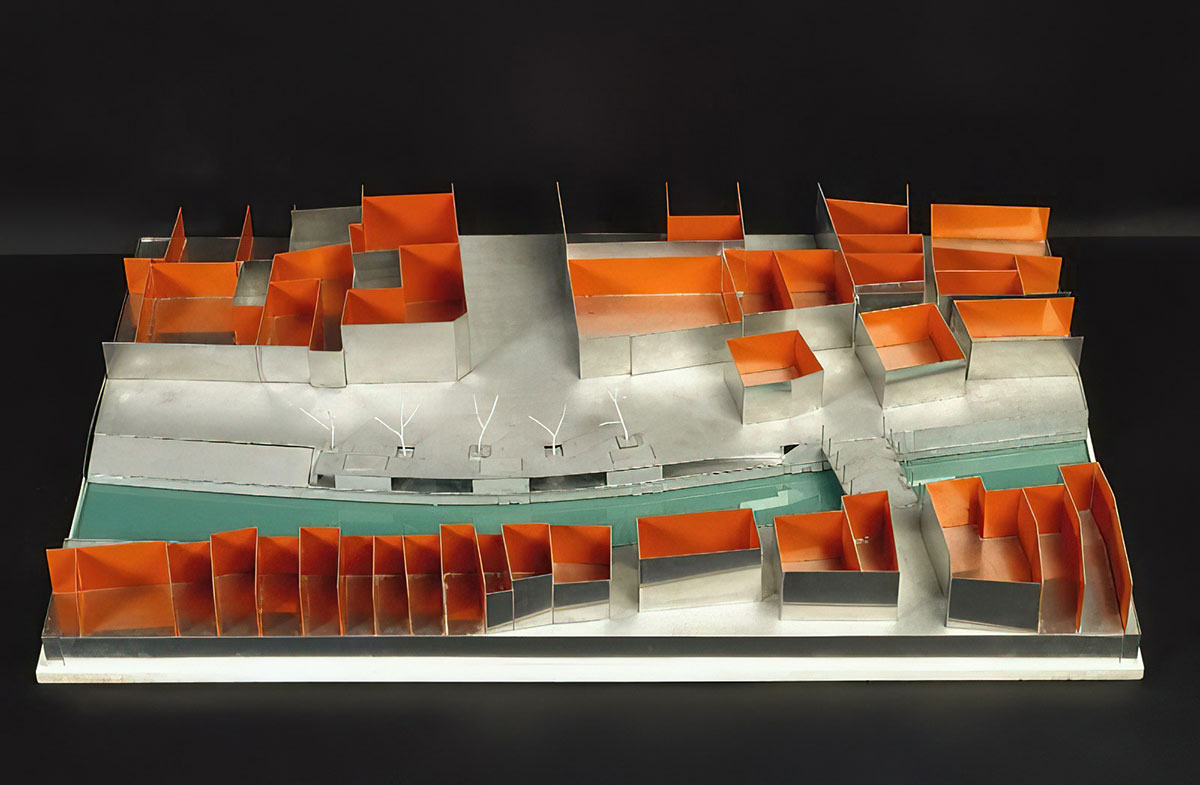
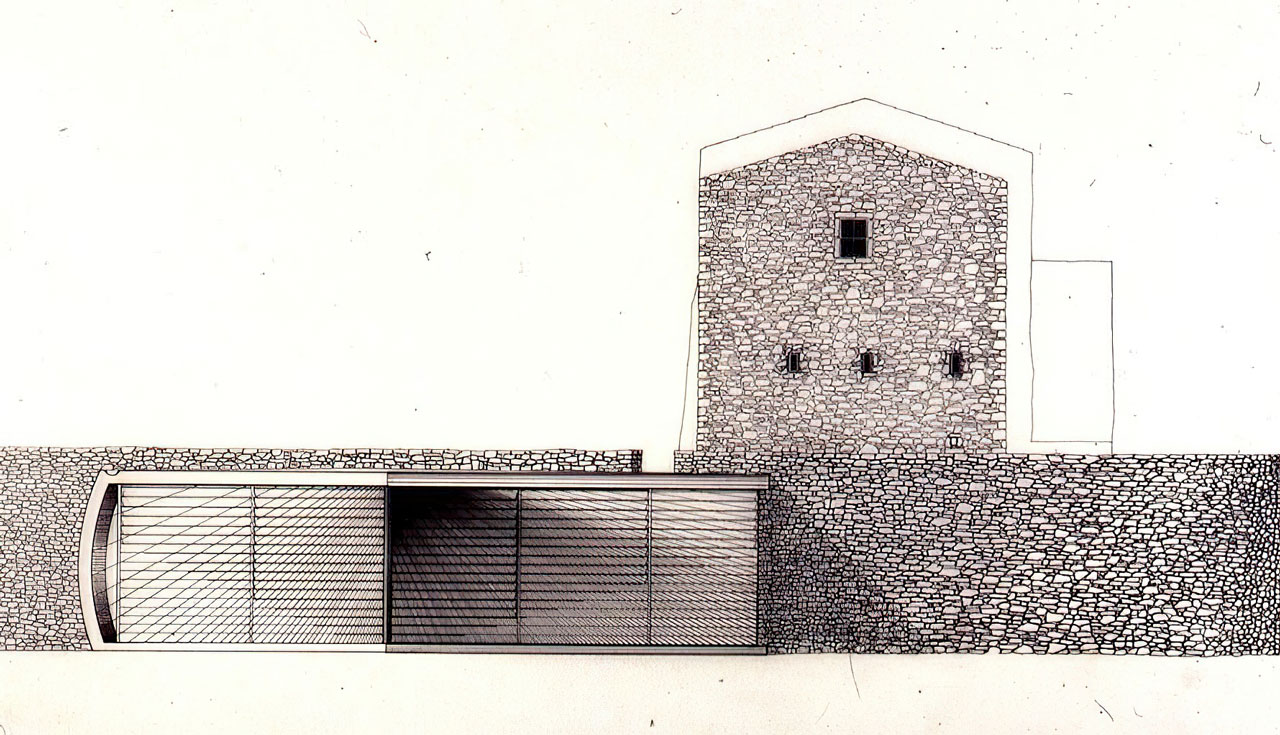
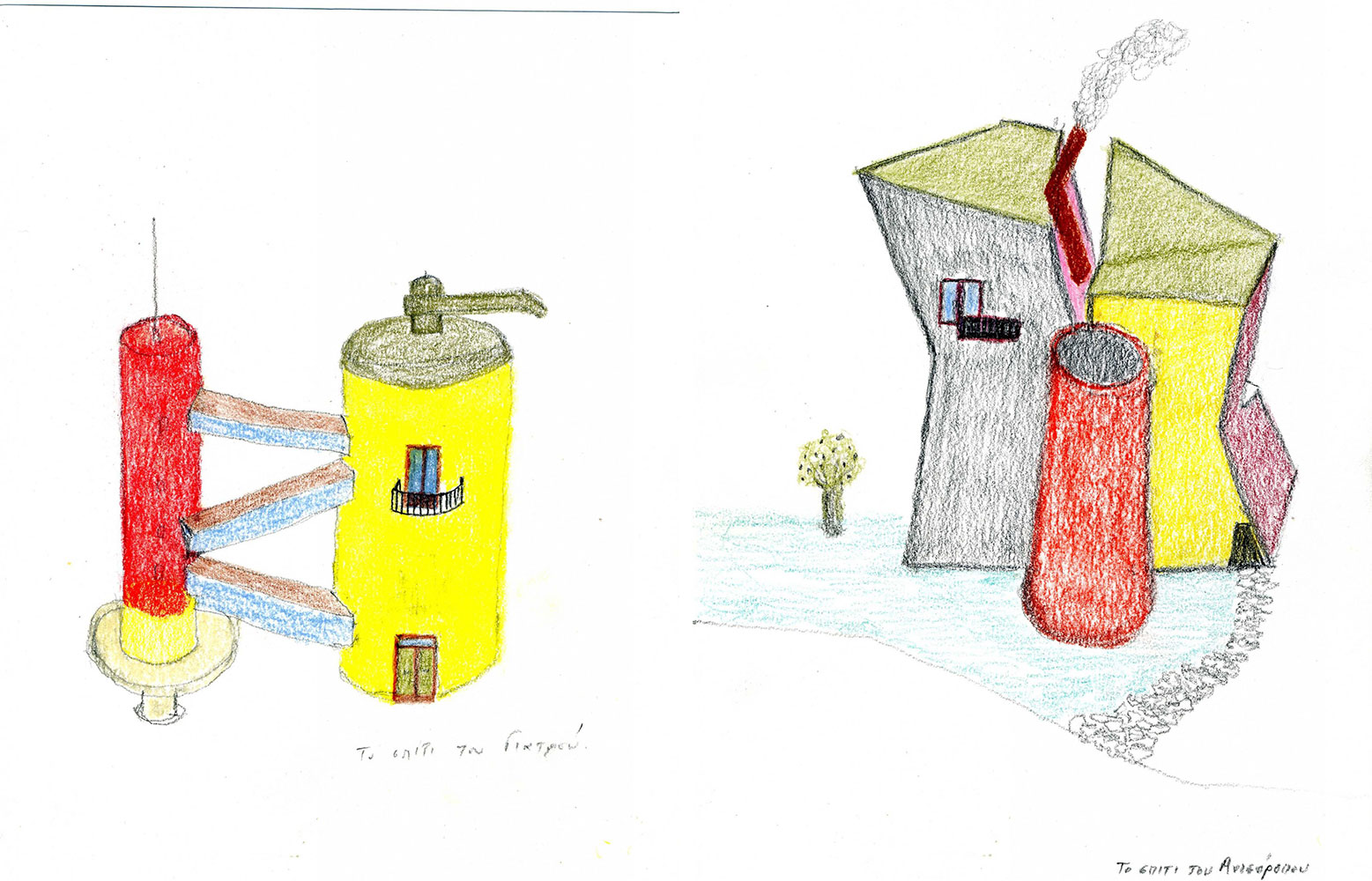
Right: Christos Papoulias, The house of the unstable man, 2014
